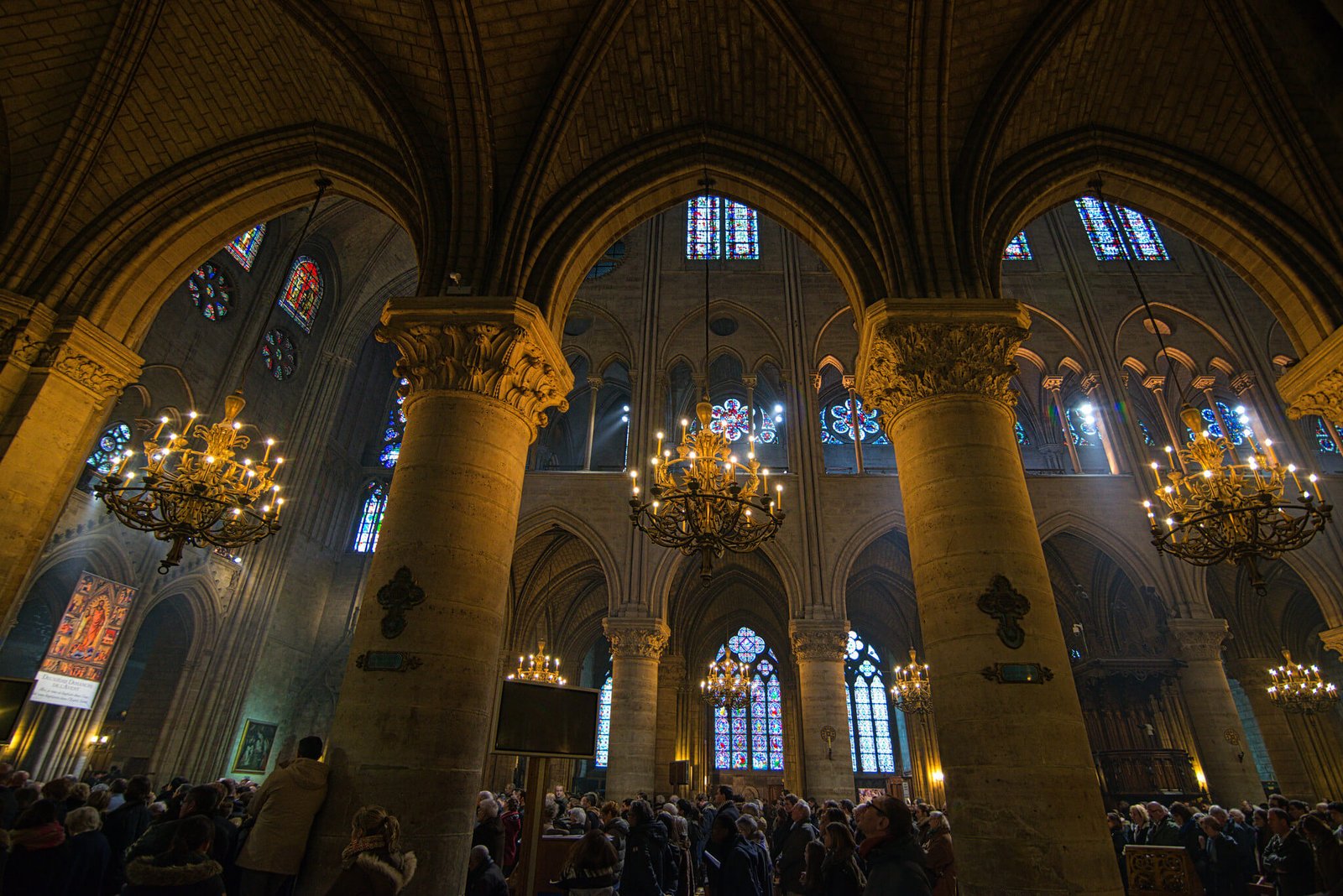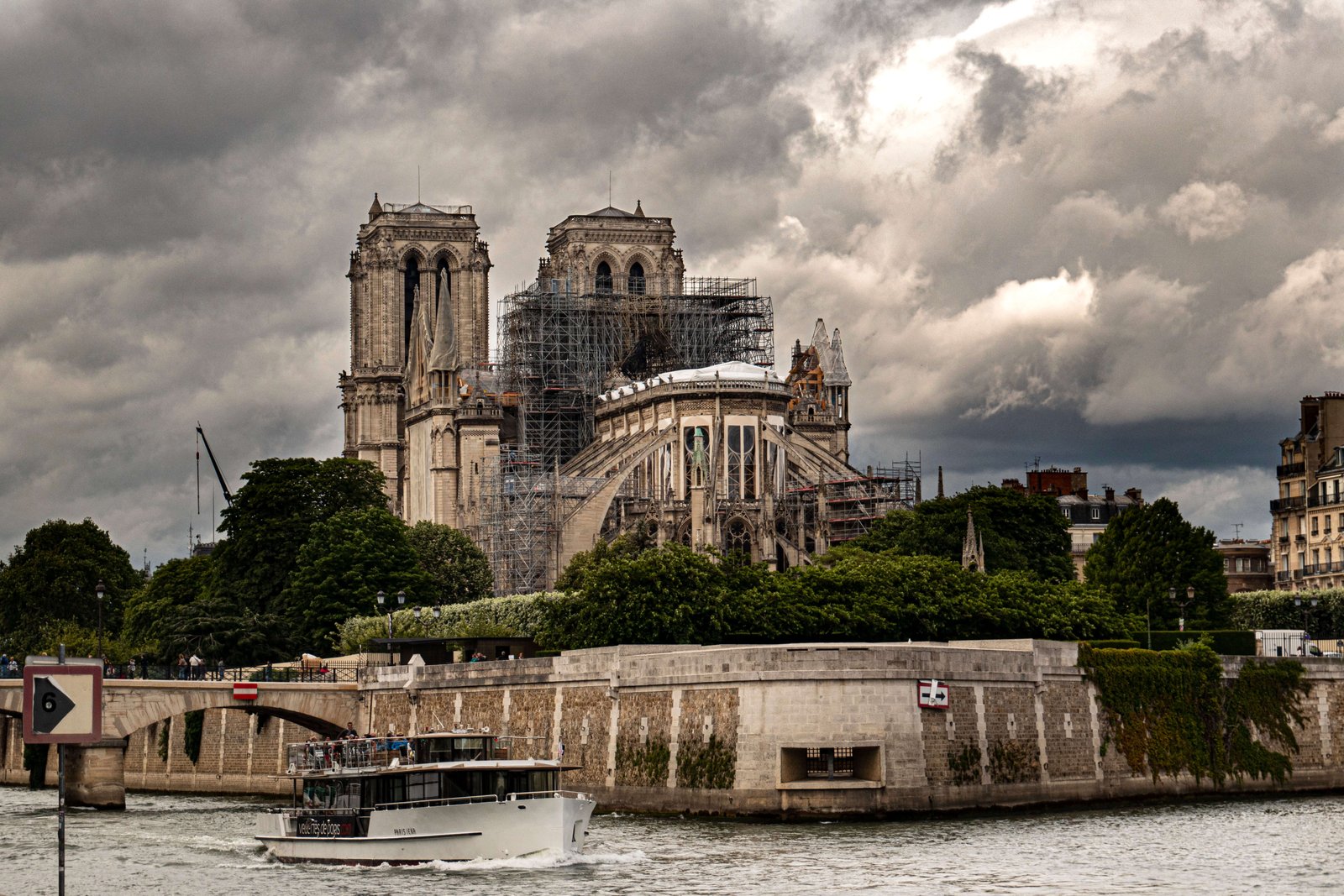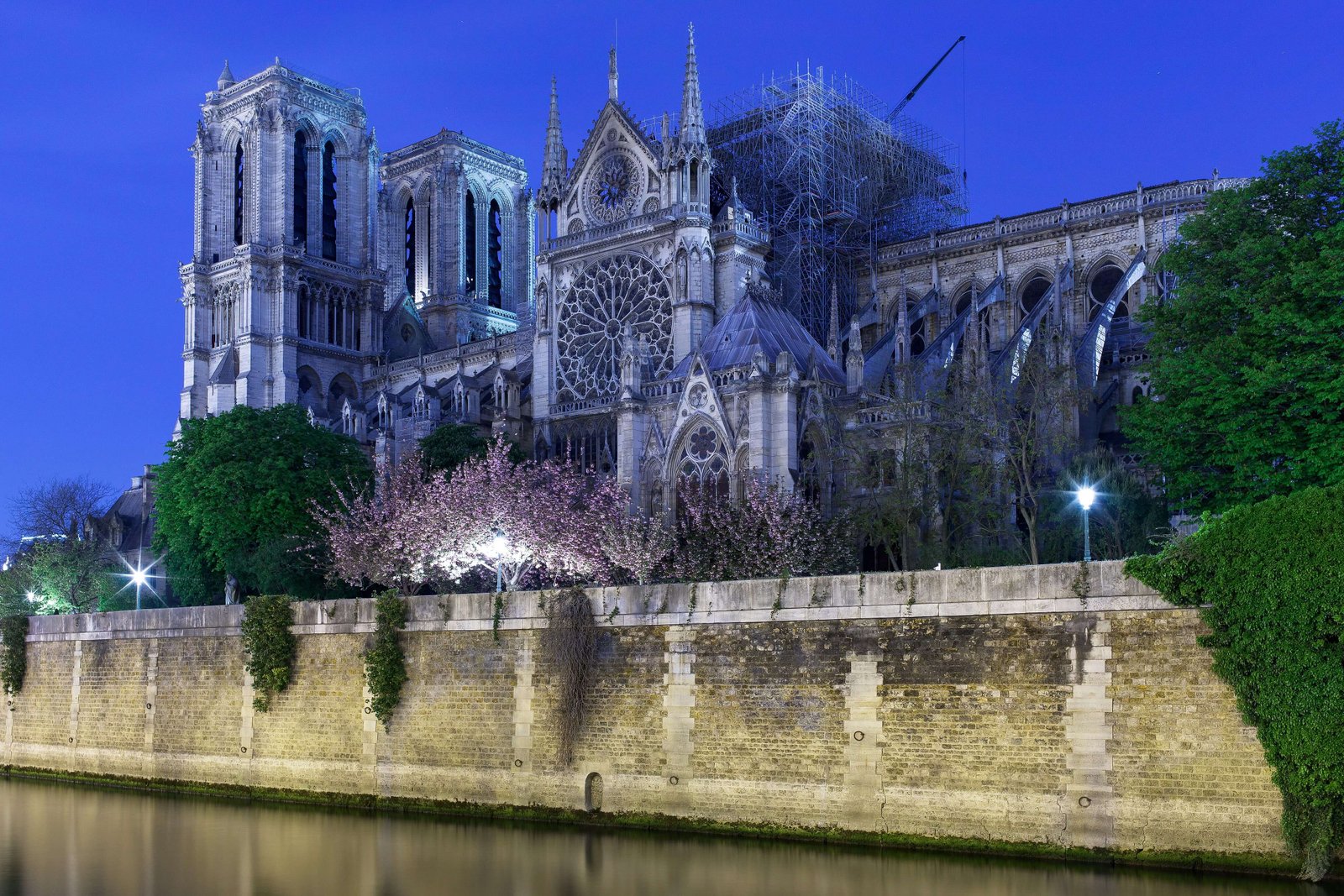On April 15, 2019, a devastating fire tore through the cathedral of Notre-Dame de Paris, the most beloved and iconic of all Gothic buildings. Largely through the heroic efforts of Paris firefighters, the building was spared the total destruction that at one point seemed inevitable. However, the damage was extensive. The 19th-century wood-and-lead spire completely collapsed and took two bays of the church’s famous rib vault with it. The medieval wooden attic, which was the fire’s point of origin, and lead-tiled roof were completely destroyed as well. The fire left the entire building vulnerable, its structure and stones weakened, and the area became a site of significant lead contamination. It wasn’t immediately clear if the building could even remain standing and what it would take to save it. There was also a lot of controversial decisions to be made concerning what a restoration would even look like. Fortunately, despite early negative forecasts and complications due to the pandemic, the reconstruction of Notre-Dame de Paris is well underway, and the restored building will look as much like the old one as possible. Almost every year since the fire, I have written something about the cathedral’s current condition and the status of the restoration. It’s all in this post.
(Cover image by Angelo Brathot via Flickr.)
2024
The roof and spire have been rebuilt using medieval materials and techniques, including master stone carving (with some new gargoyles!) and some spectacularly long and old oak beams. Notre-Dame de Paris is set to reopen to the public on December 8, 2024! In my understanding, there will still be a considerable amount of work to be completed after that, including some of the restoration they were trying to do in 2019 at the time of the fire. This is supposed to take another three years. However, this is still nothing short of a minor miracle.
There’s also a MOOC (massive open online course) about Notre-Dame de Paris now available in English. I’m not sure if it covers the restoration or just the building’s earlier history.
Source: Friends of Notre-Dame de Paris email newsletters.
2023

Happy four years of survival, Notre-Dame de Paris! For those of you looking for the latest English-language information about the cathedral’s reconstruction, let me direct you to Friends of Notre-Dame de Paris’s reconstruction progress page. (This is also where Americans can donate towards the efforts if they desire.) It sounds like the restoration efforts are going really well. They are making replacements for damaged sculptural elements and cleaning paintings, and there’s some kind of first-stage foundation for the new spire. We’ve clearly come a long way from when the building was still in danger of collapsing.
Since the Friends have done such a great job of reporting on exactly what’s going on and have actual knowledge of the project to draw from, I don’t see the need to write another update post like I have done in prior years. Back then, it was difficult to get reliable information on the church’s condition, particularly in English, and I was having to sort through conflicting accounts in the popular press. That simply isn’t the case anymore, since this information is now freely available. I particularly recommend the 60 Minutes video embedded on that page, since I found it to be very well done and not at all sensationalized. Plus, it gives you great behind-the-scenes visuals not available elsewhere.
Click here to see an article and lots of photographs about rebuilding the cathedral’s wooden attic using medieval techniques.
2021
In 2021, I had the opportunity to speak with Jo McLaughlin of Jo’s Art History Podcast about all things Notre-Dame de Paris. It turned out that I had a lot to say. We chatted about the cathedral’s history and significance, the characteristics of Gothic architecture, and of course, the fire. If you want to hear me talk extensively about one of my favorite subjects, (or you’re just wondering what my voice sounds like), you can listen on Spotify, Apple Podcasts, or YouTube. I hope everyone will enjoy it as much as I enjoyed being part of it. Thank you so much, Jo, for inviting me and being such a wonderful host!
April 15, 2021 marked the two-year anniversary of the 2019 fire that nearly destroyed Notre-Dame de Paris. To celebrate the beloved Gothic cathedral’s continued survival, which is how I prefer to think of this occasion, I’ve gathered the latest news on the building’s condition and reconstruction efforts. Although France’s coronavirus-related lockdown stopped work from March to June 2020, there has still been plenty of recent progress to celebrate.
If you need a refresher, you can read my articles about Notre-Dame right after the fire and its status one year later, both at DailyArt Magazine.
Scaffolding

As of November 2020, the melted scaffolding that has threatened the structure ever since the fire has now been completely removed. The resolution to the most pressing issue still facing the cathedral this time last year is wonderful news! The scaffolding had been installed around the spire to facilitate restoration work under way in the spring of 2019. During the fire, it melted into a deformed, unstable 200-ton mass of metal with the potential to collapse at any time. Such an occurrence would certainly have destroyed the rest of the church. The scaffolding was a hazard to both the building and the workers, but removing it was also extremely risky. Fortunately, all went well. In a delicate process, specially-trained workers rappelled down from a new scaffolding to remove the more precarious sections piece-by-piece. A large crane then removed the rest. Check out this fascinating time-lapse video of the work, which took from early June through late November.
Protecting the Building
With the dangerous scaffolding eliminated, crews could begin take steps to protect the building. In February 2021, a protective covering made Notre-Dame watertight for the first time since the fire. Installation of bracing to reinforce vulnerable structural elements continues. This work is critical, as the church’s finely-balanced architectural forces were completely thrown off by the damage to the nave vaults. Friends of Notre-Dame de Paris, an organization for North American donors to the cathedral, estimates that this “Safety Phase” of the efforts will last through this summer. Workers are also cleaning up the remaining debris and installing new scaffolding needed for the next phases of restoration.
Reconstruction Plans
Ever since the fire, controversy has raged about how to rebuild Notre-Dame’s the roof, attic, and spire. All three were completely destroyed by the blaze. As you may remember, the cathedral was significantly, and often creatively, restored in the 1840s-60s by French architect Eugene Emmanuel Viollet-le-Duc. In fact, many scholars consider modern Notre-Dame de Paris to be as much a 19th-century building, reflective of 19th-century ideas about the Middle Ages, as it is a truly medieval one. Some have seen this as a good reason to further update it during reconstruction to reflect 2020 ideals. Notre-Dame has been modified before, they argue, so why shouldn’t it be again? This line of thinking centers particularly on the spire, a 19th-century design built to replace, but not replicate, the lost medieval one. The wooden attic and lead roof were original to the structure, but their acute flammability also left then open to calls for reinterpretation, or at least reconstruction in different materials.
At first, the French government expressed interested pursuing updates, provoking a series of outlandish proposals in the days directly following the fire. The suggestion of a rooftop pool, in particular, caused a horrified outcry. The more sensational suggestions continued to make the rounds in the media until July 9, 2020, when the French government announced its decision to rebuild everything exactly as before. The new spire will look exactly like Viollet-le-Duc’s, acknowledging the fact that his design has become as integral to Notre-Dame as anything from the Middle Ages. Moreover, the new spire, attic, and roof will be remade in the same materials as before. More than 1,000 oak trees of the necessary length have already been identified and cut down, although they have to dry for a year and a half before use. Authorities are also searching for additional limestone to match the rest of the church. I’m not sure if the use of original materials includes once again covering the roof and spire in lead, or if French law even still allows building in such a hazardous material. It’s also unclear if the plans allow for fire prevention measures of any kind. I applaud the dedication to authenticity, but we’ve learned our lesson here, right?
According to the BBC, French President Emmanuel Macron credited time constraints with the decision to put things back as they used to be. He said that holding a competition and choosing a design for a new spire and roof would have made it difficult to meet his deadline of a full reconstruction by the Paris 2024 Olympics. Although many people consider his deadline unrealistic, it may have saved the Notre-Dame de Paris we all know and love.
Stepping Back Inside

It’s going to be a long time before most of us are allowed to enter Notre-Dame de Paris again. (In the meantime, I recommend visiting the church of St. Denis, just a subway ride outside Paris.) However, some people have been able to venture inside wearing hard hats. Back in December 2020, Notre-Dame’s choir performed inside the building for the first time since the fire. More recently, a very limited Holy Thursday service took place inside the cathedral on April 1, 2021.
If you are in the United States, you can donate to help the Notre-Dame restoration through the Friends of Notre-Dame de Paris.
Sources
- “Reconstruction Progress Report“. Friends of Notre-Dame de Paris.
- “Notre-Dame: Cathedral’s spire will be restored to 19th Century design“. BBC.com. July 9, 2020.
- “Notre Dame Scaffolding Removal is Complete“. Friends of Notre-Dame de Paris. December 14, 2020.
- “Notre-Dame de Paris Rebuilding Updates: January & February 2021“. Friends of Notre-Dame de Paris. January 29, 2021.
- Adamson, Thomas and Nicolas Garriga. “Four oaks, one sacred destiny: Recreating Notre Dame’s spire“. ABC News. March 9, 2021.
2020

April 15, 2020 marked exactly one year since the horrible fire that almost destroyed the cathedral of Notre-Dame de Paris. I remember sitting in my office watching the coverage in shock and trying to figure out how this could simply be a bad joke – until it became all too clear that it wasn’t. By the end of the day, I was simply grateful that this beloved building – my favorite of all time – survives in any condition at all.
In the months following the fire, I felt frustrated by sensational (and to my mind, often questionable) press coverage of the restoration efforts. Many reports took the most negative possible perspective, latching onto a few soundbites and getting people all worked up with headlines suggesting the cathedral is doomed. While the facts may not be inaccurate, the tone of these articles often felt quite slanted.
I decided I could do better, so I carefully researched and wrote this update on Notre-Dame de Paris’s condition for DailyArt Magazine. I aimed to provide a reasonable and unbiased account, acknowledging equally the conservation accomplishments and the threats still to be dealt with. Consider this my contribution to a balanced assessment of the topic and also my celebration that Notre-Dame still stands on the first anniversary of its near destruction.
“Notre-Dame de Paris – One Year Later“. Published by DailyArt Magazine, April 15, 2020.
2019

In the week after the fire, I scoured the newspapers for the latest news about the church’s fate. What resulted is probably the longest article I’ve written for DailyArt Magazine. It discusses the church’s then-current condition, why fire and medieval churches have a history of going together, some of the decisions that needed to be made before the restoration work could really begin, and more.
“Notre-Dame de Paris – Its Present and Future“. Published by DailyArt Magazine, April 22, 2019.
You can also read my personal reaction to this near-tragedy here.
Recommended Reading
Sandron, Dany and Andrew Tallon. Lindsay Cook trans. Notre Dame Cathedral: Nine Centuries of History. University Park, PA: The Pennsylvania State University Press, 2020.



